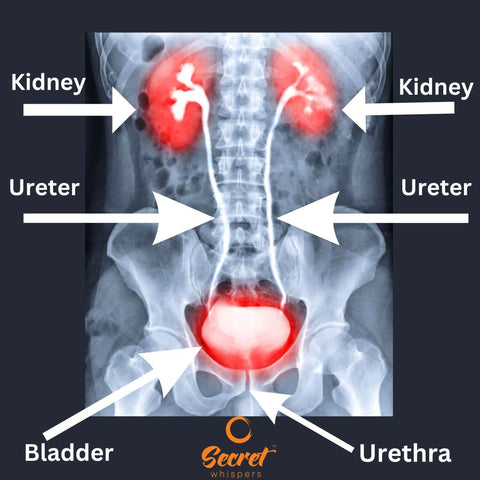UTI or Pelvic Floor Dysfunction? Understanding the Difference

As women, we often encounter various health issues that can affect our daily lives. Two common concerns that many of us may have experienced are urinary tract infections (UTIs) and pelvic floor dysfunction.
While these conditions can cause similar symptoms, it's important to understand their differences in order to seek the right treatment and take appropriate measures for our well-being.
In this blog post, we will explore both UTIs and pelvic floor dysfunction, highlighting their symptoms, risk factors, and the crucial distinctions between the two.
Urinary Tract Infection (UTI)
A urinary tract infection, or UTI, is a bacterial infection that affects any part of the urinary system, including the bladder, the urethra, two ureters, and two kidneys.

UTIs are more common in women than in men, primarily due to the shorter length of the female urethra, which allows bacteria to reach the bladder more easily.
Symptoms of UTIs often include a strong, persistent urge to urinate, a burning sensation during urination, cloudy or strong-smelling urine, and lower abdominal pain. In some cases, UTIs can cause pelvic discomfort or pressure.
It's important to note that these symptoms can vary from person to person, and some individuals may experience more severe symptoms such as fever or back pain.
To reduce the risk of developing UTIs, it's crucial to maintain good hygiene practices, such as wiping from front to back after using the toilet and urinating before and after sexual intercourse. Staying hydrated, emptying the bladder regularly, and avoiding irritants like harsh soaps or douches can also help prevent UTIs.
UTIs are also more common for those who have pelvic organ prolapse and trouble emptying their bladder completely,
TYPES OF URINARY TRACT INFECTION
Urinary tract infections (UTIs) are common bacterial infections that can affect any part of the urinary system, including the kidneys, bladder, ureters, and urethra. UTIs can vary in their severity and location within the urinary tract. Here are some of the different types of UTIs:
-
Cystitis: Cystitis is the most common type of UTI and refers to an infection that occurs in the bladder. It is often caused by bacteria entering the urethra and traveling up into the bladder. Symptoms of cystitis may include a frequent urge to urinate, a burning sensation during urination, cloudy or bloody urine, and lower abdominal pain.
-
Pyelonephritis: Pyelonephritis is a UTI that affects the kidneys. It usually starts as a lower urinary tract infection, such as cystitis, and then progresses to involve the kidneys. Symptoms of pyelonephritis can include high fever, back pain, chills, nausea, and vomiting. This type of UTI is more serious and requires prompt medical attention to prevent complications.
-
Urethritis: Urethritis is an infection that occurs in the urethra, the tube that carries urine from the bladder to the outside of the body. It is commonly caused by sexually transmitted infections (STIs) such as chlamydia or gonorrhea. Symptoms of urethritis may include pain or a burning sensation during urination, frequent urination, and discharge from the urethra.
-
Asymptomatic bacteriuria: Asymptomatic bacteriuria refers to the presence of bacteria in the urine without any accompanying symptoms. It is commonly seen in certain groups of people, such as pregnant women and individuals with urinary catheters. Although asymptomatic, it can sometimes lead to complications in susceptible individuals and may require treatment in specific situations.
Pelvic Floor Dysfunction
Pelvic floor dysfunction refers to a range of conditions that affect the muscles, ligaments, and connective tissues that support the pelvic organs, including the bladder, uterus, and rectum.
This dysfunction can result in a variety of symptoms, such as urinary incontinence (leakage of urine), bowel incontinence (leakage of faeces), pelvic pain, painful intercourse, and difficulty emptying the bladder or bowels.
There are several risk factors for pelvic floor dysfunction, including pregnancy and childbirth, obesity, aging, hormonal changes, chronic constipation, and repetitive heavy lifting. It's important to note that pelvic floor dysfunction can affect women of all ages, not just those who have given birth.
While some symptoms of pelvic floor dysfunction, such as urinary incontinence, may overlap with UTI symptoms, it's essential to understand the underlying cause. Unlike UTIs, which are caused by bacterial infections, pelvic floor dysfunction is primarily a result of weakened or overactive pelvic floor muscles.
Understanding the Overlaps and Differences
While UTIs and pelvic floor dysfunction can share similar symptoms, it's important to differentiate between the two.
UTIs are caused by bacterial infections, whereas pelvic floor dysfunction involves muscle and tissue-related issues.
UTIs often present with specific signs, such as burning sensations during urination and cloudy urine, whereas pelvic floor dysfunction symptoms can be more varied and may include pelvic pain and sexual dysfunction.
If you suspect pelvic floor dysfunction but have ruled out a UTI, it's essential to consult with your healthcare provider or a pelvic floor specialist for a proper diagnosis. They can evaluate your symptoms, medical history, and perform relevant tests to determine the cause of your pelvic floor issues.
Understanding the difference between a UTI and pelvic floor dysfunction is crucial for women's health. While both conditions can cause discomfort and impact our daily lives, they require different approaches to diagnosis and treatment. If you're experiencing symptoms, it's important to seek medical advice and discuss your concerns with a healthcare professional.
To learn more about pelvic floor health, we recommend checking out the following resources:
- What Is the Purpose of the Pelvic Floor?
- How to Know If Your Pelvic Floor Is Weak
- Is It Too Late to Start Pelvic Floor Exercises?
- How Long Does It Take to Tighten Pelvic Floor Muscles?
To learn more about pelvic floor health, we recommend checking out the following products:
Secret Whispers Pelvic Floor Toner for Women
Secret Whispers 4-Week Pelvic Floor Workout Programme

Secret Whispers 30-Day Pelvic Floor Challenge
For any questions or further assistance, feel free to reach out to us. Your pelvic floor health matters, and we're here to support you on your journey to well-being.
Never miss another blog again. Sign up now to our weekly Newsletter. You will get a 10% discount code to use too. Just click below ⬇️⬇️⬇️











